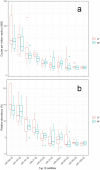The micro-RNA content of unsorted cryopreserved bovine sperm and its relation to the fertility of sperm after sex-sorting
- PMID: 33413071
- PMCID: PMC7792310
- DOI: 10.1186/s12864-020-07280-9
The micro-RNA content of unsorted cryopreserved bovine sperm and its relation to the fertility of sperm after sex-sorting
Abstract
Background: The use of sex-sorted sperm in cattle assisted reproduction is constantly increasing. However, sperm fertility can substantially differ between unsorted (conventional) and sex-sorted semen batches of the same sire. Sperm microRNAs (miRNA) have been suggested as promising biomarkers of bull fertility the last years. In this study, we hypothesized that the miRNA profile of cryopreserved conventional sperm is related to bull fertility after artificial insemination with X-bearing sperm. For this purpose, we analyzed the miRNA profile of 18 conventional sperm samples obtained from nine high- (HF) and nine low-fertility (LF) bulls that were contemporaneously used to produce conventional and sex-sorted semen batches. The annual 56-day non-return rate for each semen type (NRRconv and NRRss, respectively) was recorded for each bull.
Results: In total, 85 miRNAs were detected. MiR-34b-3p and miR-100-5p were the two most highly expressed miRNAs with their relative abundance reaching 30% in total. MiR-10a-5p and miR-9-5p were differentially expressed in LF and HF samples (false discovery rate < 10%). The expression levels of miR-9-5p, miR-34c, miR-423-5p, miR-449a, miR-5193-5p, miR-1246, miR-2483-5p, miR-92a, miR-21-5p were significantly correlated to NRRss but not to NRRconv. Based on robust regression analysis, miR-34c, miR-7859 and miR-342 showed the highest contribution to the prediction of NRRss.
Conclusions: A set of miRNAs detected in conventionally produced semen batches were linked to the fertilizing potential of bovine sperm after sex-sorting. These miRNAs should be further evaluated as potential biomarkers of a sire's suitability for the production of sex-sorted sperm.
Keywords: bull fertility; miRNA; microRNA; sex-sorted sperm; small RNA-seq.
Conflict of interest statement
UW and SW were employees of Swissgenetics (Swissgenetics, Meielenfeldweg 12, CH-3052 Zollikofen BE, Switzerland;
Figures






Similar articles
-
Expression of miRNAs in Bull Spermatozoa Correlates with Fertility Rates.Reprod Domest Anim. 2015 Aug;50(4):587-94. doi: 10.1111/rda.12531. Epub 2015 May 21. Reprod Domest Anim. 2015. PMID: 25998690
-
Small RNA sequencing of cryopreserved semen from single bull revealed altered miRNAs and piRNAs expression between High- and Low-motile sperm populations.BMC Genomics. 2017 Jan 4;18(1):14. doi: 10.1186/s12864-016-3394-7. BMC Genomics. 2017. PMID: 28052756 Free PMC article.
-
Changes in miRNA levels of sperm and small extracellular vesicles of seminal plasma are associated with transient scrotal heat stress in bulls.Theriogenology. 2021 Feb;161:26-40. doi: 10.1016/j.theriogenology.2020.11.015. Epub 2020 Nov 27. Theriogenology. 2021. PMID: 33278692
-
Expression of sperm microRNAs related to bull fertility: A systematic review.Res Vet Sci. 2024 Jan;166:105077. doi: 10.1016/j.rvsc.2023.105077. Epub 2023 Nov 4. Res Vet Sci. 2024. PMID: 37948882
-
Current status of sperm functional genomics and its diagnostic potential of fertility in bovine (Bos taurus).Syst Biol Reprod Med. 2018 Dec;64(6):484-501. doi: 10.1080/19396368.2018.1444816. Epub 2018 Mar 14. Syst Biol Reprod Med. 2018. PMID: 29537884 Review.
Cited by
-
Multi-omics data integration for the identification of biomarkers for bull fertility.PLoS One. 2024 Feb 23;19(2):e0298623. doi: 10.1371/journal.pone.0298623. eCollection 2024. PLoS One. 2024. PMID: 38394258 Free PMC article.
-
Study of Small Non-Coding RNA (miRNA) Expression Pattern of Fertile/Infertile Male Semen.Acta Inform Med. 2022 Sep;30(3):205-212. doi: 10.5455/aim.2022.30.205-212. Acta Inform Med. 2022. PMID: 36311149 Free PMC article.
-
Characterization of the Impact of Density Gradient Centrifugation on the Profile of the Pig Sperm Transcriptome by RNA-Seq.Front Vet Sci. 2021 Jul 19;8:668158. doi: 10.3389/fvets.2021.668158. eCollection 2021. Front Vet Sci. 2021. PMID: 34350225 Free PMC article.
-
Comprehensive analysis of microRNA and metabolic profiles in bovine seminal plasma of different semen quality.Front Vet Sci. 2023 Mar 28;10:1088148. doi: 10.3389/fvets.2023.1088148. eCollection 2023. Front Vet Sci. 2023. PMID: 37056229 Free PMC article.
-
Significance and Relevance of Spermatozoal RNAs to Male Fertility in Livestock.Front Genet. 2021 Dec 9;12:768196. doi: 10.3389/fgene.2021.768196. eCollection 2021. Front Genet. 2021. PMID: 34956322 Free PMC article. Review.
References
-
- Hutchison JL, Bickhart DM. Sexed-semen usage for Holstein AI in the United States. J Anim Sci. 2016;94 Suppl 5:180. doi: 10.2527/jam2016-0372. - DOI
-
- Heuer C, Kendall D, Sun C, Deeb J, Moreno J, Vishwanath R. Evaluation of conception rates of sex-sorted semen in commercial dairy farms over the last five years. In: ADSA annual meeting. PIttsburgh, Pennsylvania: American Dairy Science Association; 2017.
MeSH terms
Substances
Grants and funding
LinkOut - more resources
Full Text Sources
Other Literature Sources
Research Materials
Miscellaneous

